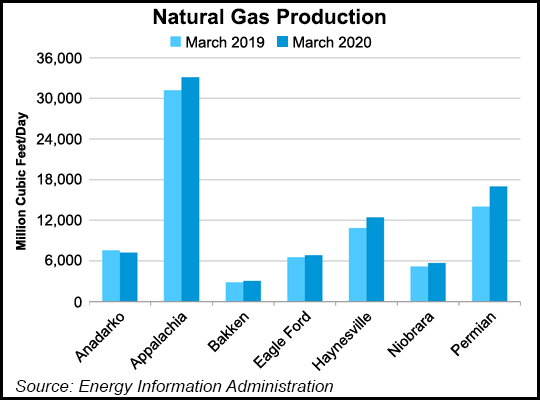Shale Daily | E&P | NGI All News Access
Inflection Point? EIA Forecasts End to Three Years of Nonstop NatGas Production Growth
For the first time in three years, the Energy Information Administration (EIA) is predicting a month-to-month decline in total natural gas production from seven of the most prolific onshore U.S. unconventional plays in March, and oil production is expected to remain virtually flat.

Total natural gas production from the Anadarko, Appalachian and Permian basins, and the Bakken, Eagle Ford, Haynesville and Niobrara formations, is expected to be 85.45 Bcf/d in March, compared with 85.62 Bcf/d in February, EIA said in its latest Drilling Productivity Report (DPR), which was released Tuesday.
Declines in gas production are expected in the Anadarko (7.23 Bcf/d, compared with 7.40 Bcf/d), Appalachia (33.13 Bcf/d, compared with 33.35 Bcf/d), Bakken (3.07 Bcf/d, compared with 3.08 Bcf/d), Eagle Ford (6.86 Bcf/d, compared with 6.88 Bcf/d), and Niobrara (5.71 Bcf/d, compared with 5.73 Bcf/d). Increases are expected in the Haynesville (12.44 Bcf/d, compared with 12.41 Bcf/d) and Permian (16.98 Bcf/d, compared with 16.79 Bcf/d).
At the same time, total oil production from the seven plays is expected to increase by only 18,000 b/d in March from February. EIA said it expects the plays to produce 9.18 million b/d in March, with the Permian the only play expected to see a month/month increase (4.86 million b/d, compared with 4.82 million b/d this month).
Decreases in oil production are expected in the Anadarko (526,000 b/d, compared with 536,000 b/d), Appalachia (145,000 b/d, compared with 146,000 b/d), and Niobrara (769,000 b/d, compared with 777,000 b/d). The Bakken is forecast to produce 1.47 million b/d, a marginal decrease compared with February, and output from the Eagle Ford (1.37 million b/d) and Haynesville (39,000 b/d) are expected to be unchanged month/month.
EIA has reported consecutive month-to-month increases out of the seven plays since January 2017, when total gas production was about 47.51 Bcf/d, and total oil production was an estimated 4.54 million b/d.
Drilled but uncompleted (DUC) well counts across the Big Seven ended January at 7,682, a decrease of 34 from December, EIA said. DUCs decreased in four plays, with the Anadarko down by 50 to 711, Appalachia down by six to 537, the Eagle Ford down by 12 to 1,392, and the Niobrara down by 10 to 457. The Bakken added 27 DUCs to reach 841, the Haynesville added three to 240, and the Permian added 14 to reach 3,504.
The productivity of new gas wells in the Big Seven plays is expected to decrease by 13 Mcf/d in March to 3.85 MMcf/d. At the same time, new well oil production per rig is expected to increase by 18 b/d during the month to 853 b/d.
EIA compiles the DPR using recent U.S. data on the total number of drilling rigs in operation along with estimates of drilling productivity and estimated changes in output from existing wells to provide estimated changes in production.
© 2024 Natural Gas Intelligence. All rights reserved.
ISSN © 2577-9877 | ISSN © 2158-8023 |
